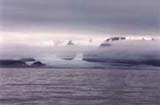A site on Baranof Island shows that people with an unmistakable northwest coast culture have been in the region for at least the last 3,000 years. Lower Glacier Bay was habitable for many centuries up until about 300 years ago. In 1794, as the mother ship H.M.S. Discovery, Captained by George Vancouver, arrived, this area was terminated by solid compact mountains of ice.

Area of Glacier Bay has been dramatically changed in last 200 years. Glacial movements past and present complicate the distribution of species. As glaciers retreat, a new barren land emerges. Highly adaptable plant forms begin to colonize this sterile environment. Seeds and spores are transported by birds and carried by wind to the exposed land surfaces. Lichens, algae and mosses produce a fertile blanket on which succeeding plants can grow. Horsetail, fireweed, dryas and willow shrubs are the early pioneers. Alder, an important nitrogen fixing plant, followed by cottonwood, is usually the first tree to develop. These set the stage for the later and climactic plant species to play their role in the plant succession drama.

While birds and marine life are mobile enough to recolonize quickly, mammals have a more difficult problem. Some mammal species have not reached Glacier Bay since the last major ice age drew to a close. If ice covered nearly all lowland areas between Seward Peninsula, Alaska and Puget Sound, Washington, within the last 12,000 years, then it is understandable why the distribution of animals is not yet complete. However, this has not prevented most species from colonizing Glacier Bay. In recent times, the coyote, moose and wolf have found suitable habitat in the park. The mountain goat and brown bear, both highly mobile creatures, have roamed the region for thousands of years. As a result, these species have had less difficulty finding habitat. Many smaller mammals such as the vole, wolverine, marmot and porcupine are found in the park as well. Marine mammals include the humpback whale, killer whale, harbor porpoise, harbor seal, Steller sea lion, and sea otter. There are currently about 40 different species of mammals in Glacier Bay National Park and Preserve.


